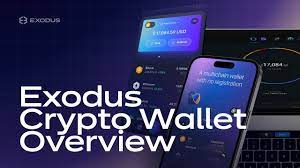In the rapidly evolving world of cryptocurrency, having a secure and reliable exodus wallet download to store your digital assets is paramount. Exodus Wallet has gained significant attention for its ease of use, functionality, and beautiful user interface. This multi-currency wallet allows users to manage their crypto holdings in a seamless and intuitive way. In this article, we will dive into the features, advantages, and drawbacks of Exodus Wallet, helping you decide if it’s the right choice for you.
What is Exodus Wallet?
Exodus Wallet is a software-based, non-custodial cryptocurrency wallet, meaning it allows users to have full control over their private keys and funds. Founded in 2015 by JP Richardson and Daniel Castagnoli, Exodus has quickly risen to become one of the most popular wallets for both beginners and experienced crypto enthusiasts. It supports a wide variety of cryptocurrencies, including Bitcoin, Ethereum, Litecoin, and many altcoins, making it an all-in-one solution for managing your digital assets.
Key Features of Exodus Wallet
- Multi-Currency Support One of the standout features of Exodus is its support for over 100 different cryptocurrencies. Whether you’re holding Bitcoin, Ethereum, or lesser-known altcoins, Exodus has you covered. This makes it an attractive choice for users with diverse portfolios.
- User-Friendly Interface Exodus is known for its sleek, easy-to-navigate interface. Unlike many other crypto wallets that can seem daunting for beginners, Exodus focuses on a visually appealing design that simplifies the process of managing crypto. The wallet’s main dashboard displays your portfolio and provides quick access to your assets.
- Built-In Exchange Exodus offers an integrated exchange service that allows users to swap one cryptocurrency for another directly within the wallet. The wallet partners with ShapeShift to facilitate these swaps, and it supports a variety of trading pairs. This eliminates the need for users to leave the wallet and use an external exchange to make transfers.
- Security Features Security is a top priority for Exodus. The wallet is non-custodial, meaning you control your private keys. Exodus also provides robust backup and recovery options, including a 12-word recovery phrase to restore your wallet if lost. While it does not support two-factor authentication (2FA) at the moment, it does integrate well with hardware wallets like Trezor for enhanced security.
- Cross-Platform Compatibility Exodus Wallet is available on multiple platforms, including Windows, macOS, and Linux desktops, as well as mobile apps for iOS and Android. The wallet synchronizes seamlessly across devices, making it easy to access your funds from anywhere.
- Portfolio Tracker The wallet comes with a built-in portfolio tracker that allows you to view the real-time value of your holdings. The tracker also provides insights into your asset allocation, helping you monitor your investment performance.
- Customer Support Exodus offers strong customer support with a comprehensive help center, including guides and FAQs. The team is also available for direct support via email, which is especially helpful for users encountering technical issues.
Pros of Using Exodus Wallet
- Intuitive and Easy to Use: With its simple interface, Exodus is perfect for beginners in the crypto space who might feel overwhelmed by more complex wallets.
- Non-Custodial: Exodus ensures that users have full control over their funds and private keys, which is essential for maintaining privacy and security.
- Built-in Exchange: The ability to swap cryptocurrencies directly within the wallet is a major convenience, making Exodus an excellent choice for those who need to trade on the go.
- Portfolio Management: The portfolio tracker and insights are incredibly useful for users who want to stay on top of their investments.
- Multi-Currency Support: With support for more than 100 cryptocurrencies, Exodus is a versatile wallet that can accommodate a wide range of digital assets.
Cons of Using Exodus Wallet
- No Two-Factor Authentication (2FA): While Exodus has strong encryption, it does not currently offer 2FA, which is an important security feature that many other wallets support.
- No Web Version: While Exodus has apps for desktops and mobile devices, it does not offer a web-based version, limiting access to users who rely on browser-based solutions.
- Limited Advanced Features: Advanced users who need features like staking or advanced trading options may find Exodus lacking. It’s designed more for everyday users rather than active traders or professionals.
Exodus Wallet and Privacy
Exodus Wallet respects your privacy by not requiring any personal information to create an account. As a non-custodial wallet, you are the only one who holds the keys to your funds. This gives you a high level of privacy compared to custodial wallets where the service provider holds control over your private keys.
However, it is important to note that the wallet does interact with third-party services for features like the integrated exchange. While Exodus does not store your personal data, it’s always a good idea to review the privacy policies of third-party services integrated into the wallet.
Exodus Wallet on Mobile
The mobile version of Exodus offers all the features available on the desktop version, including the ability to manage your portfolio, track your holdings, and make crypto swaps. The mobile app is especially useful for on-the-go crypto management. The app’s design is fluid and responsive, providing a great user experience on both iOS and Android devices.
How to Set Up Exodus Wallet
Setting up Exodus is straightforward:
- Download the Wallet: Go to the official Exodus website or download the app from the App Store or Google Play Store.
- Create Your Wallet: Once you’ve installed the wallet, you’ll be prompted to create a new wallet or restore an existing one. If creating a new wallet, make sure to save your 12-word recovery phrase in a secure location.
- Add Cryptocurrencies: After setup, you can start adding assets to your wallet. Exodus automatically generates receiving addresses for the various cryptocurrencies it supports.
- Backup Your Wallet: Ensure you back up your wallet by writing down the recovery phrase and storing it securely.
- Start Transacting: You’re now ready to receive, send, or exchange cryptocurrencies directly within the wallet.
Conclusion
Exodus Wallet stands out in the cryptocurrency space for its combination of simplicity, security, and powerful features. It’s ideal for those who want an easy-to-use wallet with the ability to manage a wide range of cryptocurrencies, swap assets, and track investments. While it lacks some advanced features and two-factor authentication, Exodus remains one of the best choices for beginners and casual users looking for a secure and user-friendly wallet.
If you’re new to crypto and want a hassle-free way to store and manage your assets, Exodus Wallet could be a perfect fit. However, if you’re a more advanced user or trader, you might want to explore additional options that offer enhanced security and trading features.


